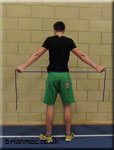

Static Flexibility Test - Shoulder
Testing and measurement are the means of collecting information upon which subsequent performance evaluations and decisions are made. In the analysis, we need to consider factors influencing the results.
Objective
This test aims to monitor the development of the athlete's shoulder flexibility/mobility.
Required Resources
To conduct this test, you will require:
- A piece of rope approx. 1 metre in length.
- Tape measure.
- Assistant.
How to conduct the test
- The athlete warms up for 10 minutes.
- The athlete holds the rope in front of them with both hands shoulder-width apart.
- The athlete extends the arms over their head and down behind them (allowing the hands to slide along the rope as they do so) until the rope touches their lower back.
- The athlete holds the final position whilst measurements are recorded.
- The assistant measures and records the distance between the tips of the athlete's thumbs.
- The assistant measures and records the shoulder width.
- The assistant subtracts the shoulder measurement from the thumb measurement and records the result.
- The test is repeated three times, and the longest distance, following subtraction, is used to assess the athlete's performance.
 |
 |
 |
Analysis
The test result is analysed by comparing it with the athlete's previous results for this test. It is expected that the analysis would indicate an improvement in the athlete's shoulder flexibility with appropriate training between each test.
Target Group
These tests are suitable for active individuals but not for those where the test would be contraindicated.
Reliability
Test reliability refers to how a test is consistent and stable in measuring its intended measure. Reliability will depend upon how strictly the test is conducted and the individual's level of motivation to perform the test. The following link provides various factors influencing the results and test reliability.
Validity
Test validity refers to the degree to which the test measures what it claims to measure and the extent to which inferences, conclusions, and decisions based on test scores are appropriate and meaningful. This test provides a means to monitor training on the athlete's physical development.
Advantages
- Minimal equipment required
- Simple to set up and conduct
- It can be conducted almost anywhere
Disadvantages
- Assistant required to administer the test
References
- JOHNSON, B.L. and NELSON, J.K. (1986) Practical Measurements for Evaluation in PE. 4th ed. Minneapolis: Burgess Publishing
Page Reference
If you quote information from this page in your work, then the reference for this page is:
- MACKENZIE, B. (2007) Static Flexibility Test - Shoulder [WWW] Available from: https://www.brianmac.co.uk/flextest4.htm [Accessed